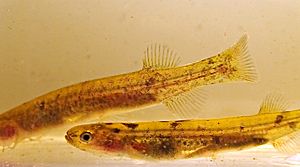Tasmanian mudfish facts for kids
Quick facts for kids Tasmanian mudfish |
|
|---|---|
 |
|
| N. cleaveri in Tasmania, Australia | |
| Conservation status | |
| Scientific classification | |
| Genus: |
Neochanna
|
| Species: |
cleaveri
|
The Tasmanian mudfish, also known as Neochanna cleaveri, is a small fish found in Australia. It belongs to a family of fish called galaxiids. These fish are special because they can live in both fresh water and the sea during different parts of their lives.
Contents
Where the Tasmanian Mudfish Lives
You can find the Tasmanian mudfish in wet areas along the coast of southeastern Australia. This includes places like Tasmania, Flinders Island (which is in Bass Strait), and southern Victoria. They are especially common around Wilsons Promontory.
Some smaller groups of these fish live in other parts of Victoria, like the Otways, near Geelong and Melbourne. You can also find them in far eastern South Australia, close to Naracoorte.
Sadly, the areas where these fish live have become much smaller. This is mostly because people have changed their natural homes. For example, swamps have been drained and filled in for human use.
What the Tasmanian Mudfish Looks Like
The Tasmanian mudfish looks like other galaxiid fish. It has a long, tube-shaped body and no scales. Its mouth is a medium size.
You can tell it apart from other fish by its small eyes and a blunt, rounded head. It has special tube-like nostrils that stick out over its upper lip. Its fins are rounded. The fins on its belly are small and are about halfway along its body. The fins on its back and underside are set far back, with the back fin slightly in front of the underside fin. Its tail fin is rounded and has strong edges that reach almost to the back of the other fins.
These fish are usually greenish-brown, sometimes with a golden color. Their bellies are grayish. They have irregular, darker patterns and spots over their back, sides, and near their fins. The Tasmanian mudfish can grow up to 140 millimeters (about 5.5 inches) long, but they are usually around 80 millimeters (about 3 inches).
Where the Mudfish Makes its Home
This type of fish mostly lives in muddy swamps, marshes, and drains. These places usually have a lot of plants growing in them. The groups of mudfish that are now separated in Victoria were probably once part of a much larger group. This was before Europeans came to Australia and changed the land.
Why This Fish is Important
While some Tasmanian mudfish might have been caught by people fishing for "whitebait" (young fish), they were likely only a small part of the catch. These fish can live well in tanks and are easy to care for. However, they are shy and mostly active at night, which makes them less popular as pets.
Protecting the Tasmanian Mudfish
The Tasmanian mudfish is not listed as a threatened species across all of Australia. This is because there are still many of them in Tasmania. However, in Victoria, this fish is listed as critically endangered. This means it is in great danger of disappearing there. This listing is under the Victorian Flora and Fauna Guarantee Act, which helps protect plants and animals.
Tasmanian Mudfish Life Cycle
Tasmanian mudfish lay their eggs in late winter. When the eggs hatch, the tiny fish larvae are carried out to sea. They spend about two to three months in the ocean or in river mouths. After this time, they swim back to fresh water as part of the "whitebait" migration.
Young Tasmanian mudfish are smaller than other fish in the whitebait group. They are usually only 30 to 40 millimeters (about 1 to 1.5 inches) long when they return to fresh water. These young fish then swim upstream to find their usual homes.
The mudfish are active at night and like to stay hidden. During the day, they usually rest among thick plants or partly buried in the muddy bottom. If their home dries up in summer or during a drought, N. cleaveri can survive by aestivating. This means they bury themselves horizontally in the mud or find moist spots under rocks and logs to stay wet until the water returns.
Naming the Mudfish
The Tasmanian mudfish has a few other common names. These include Australian mudfish, mud trout, and mud galaxias.
It also had other scientific names in the past, such as Galaxias cleaveri, Saxilaga cleaveri, Saxilaga anguilliforms, and Galaxias upcheri.
The name of its group, Neochanna, comes from two Greek words. Neos means "new," and Channa is the name of a group of Asian fish that can also survive dry periods. The species name, cleaveri, was given to honor Mr. F. Cleaver, who was the first person to collect this fish.


